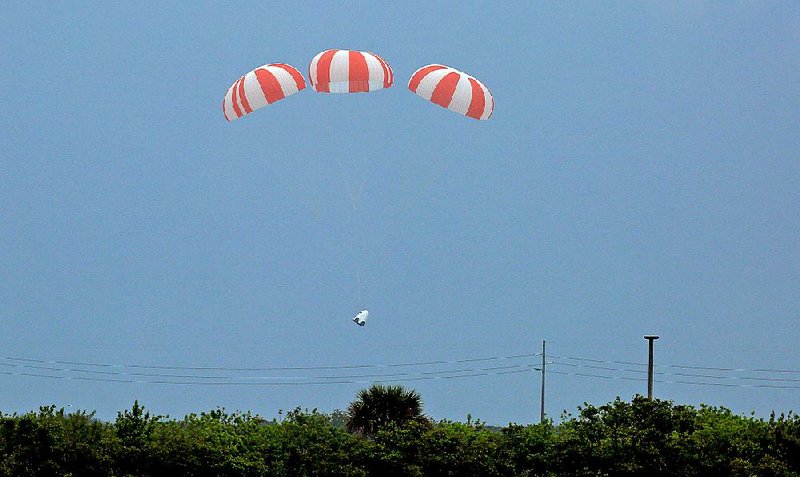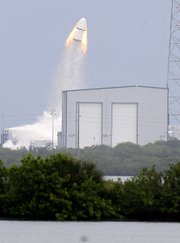CAPE CANAVERAL, Fla. -- SpaceX chalked up another big test flight Wednesday, firing a capsule into the air to try out its new launch-escape system for astronauts.
No humans were on board for the flight, just a life-size dummy. The test took only 1½ minutes, but it was a milestone in SpaceX's effort to get America back to the business of launching astronauts from U.S. soil.
SpaceX Chief Executive Officer Elon Musk called it a great outcome, and NASA offered congratulations.
"Had there been people on board, they would have been in great shape," Musk said by phone from California, where his company is based.
"This bodes quite well for the future of the program," he said, quickly adding, "I don't want to jinx it."
The Dragon capsule shot off a test stand, not a rocket, and flew up and then out over the Atlantic. Eight rocket engines on the capsule provided the thrust. Red and white parachutes popped open and slowed the capsule's fall into the ocean, just offshore.
"This flight test is unlike any seen in Florida since the days of Apollo," NASA spokesman Mike Curie, the TV commentator for the test, said after the capsule plopped into the Atlantic. Recovery boats and a barge moved in to retrieve the craft.
SpaceX already hauls cargo to the International Space Station in a Dragon capsule for NASA; another supply run is set for next month.
Determined to crack the human spaceflight arena and put people on Mars, Musk aims to launch U.S. astronauts to the orbiting lab as early as 2017, allowing NASA to reduce its reliance on Russia to ferry crews. The last manned launch from Cape Canaveral was in 2011 when the U.S. shuttle program ended.
Boeing also is developing a crew capsule for NASA. The space agency wants to make sure the commercial crew flights will be safe in an emergency, and is insisting on reliable escape systems.
Addressing reporters two hours after the test, Musk said he did not have specifics on how high or how far offshore the capsule flew. The anticipated altitude was a mile, and the splashdown zone a mile offshore.
He said all eight engines fired -- although one was slightly off the mark -- and that the capsule went from zero to 100 mph in 1.2 seconds.
"That's pretty zippy," Musk said.
Top speed was 345 mph.
In the days leading up to the trial run, SpaceX officials had cautioned something might go wrong. The capsule could have been lost at sea or smashed down onto the Cape Canaveral Air Force Station, from where it took off. A 2-mile area was cleared before the test, just in case.
SpaceX said its revolutionary launch-abort system, once perfected, will provide an escape for astronauts throughout their climb to orbit, something even NASA's early manned spacecraft could not do.
The pointy launch-escape towers atop the Mercury and Apollo capsules were good for just the initial part of liftoff; the same is true of the Russian Soyuz spacecraft. The two-man Gemini capsules relied on ejection seats, as did the first four space shuttle flights.
Only the Russians ever used their escape system during a real manned launch -- in 1983 -- and it saved two cosmonauts' lives. Seven U.S. astronauts later died in the 1986 Challenger accident, and seven others in the 2003 loss of the Columbia shuttle, showing NASA just how valuable an abort system can be.
SpaceX plans to use the capsule again later this year for an abort test after an actual rocket launch from Vandenberg Air Force Base in California.
A Section on 05/07/2015

